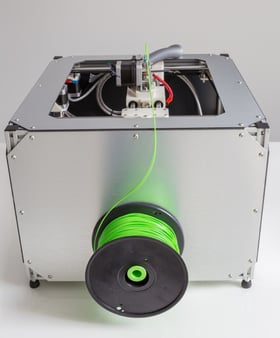Complex designs, mass customization, and cost effectiveness are among the benefits of this innovative technology.
3D printing has recently been capturing an unprecedented number of headlines, even though the technology has been around since the 1980s. Also known as additive manufacturing, 3D printing can fuse layers of powdered material via a laser, and disburse melted plastic or a similar material through nozzles. The technology essentially fabricates a product layer by layer based on a design file.
W hen they were first invented, 3D printers were prohibitively expensive. Their initial massive size meant that they were cumbersome and impractical for consumers and most manufacturers. They were originally used for product development, data visualization, and rapid prototyping.
hen they were first invented, 3D printers were prohibitively expensive. Their initial massive size meant that they were cumbersome and impractical for consumers and most manufacturers. They were originally used for product development, data visualization, and rapid prototyping.
Since 2010, however, there have been rapid advancements in the technology. They are far more accessible to manufacturers. Companies like Stratasys are making 3D printers for rapid prototyping, while MakerBot and Formlabs are offering more economical 3D printers for independent enthusiasts.
Here are five advantages of 3D printing for manufacturers and engineers.
Complex Geometries
One of the greatest advantages of 3D printing is the potential for producing components and parts with complex designs. Since designs can be made digitally, products do not need to be limited by geometric complexity. This means that manufacturers can produce stronger and lighter components, a fact of which the aerospace industry in particular is taking advantage.
Mass Customization
Along with freedom in complexity comes the option to customize a product to almost any requirement. 3D printing technology allows manufacturers to create multiple products inside the same build chamber, each designed to respond to different end-user requirements.
Less Tooling
Additive manufacturing allows products with complex designs to be made with one machine. This reduces the total number of steps in the process, as well as the amount of tooling necessary at each step. The final product can be made faster and requires fewer parts.
Fewer Costs
By being able to fabricate products with less overall parts and assembly, 3D printing allows you to save the cost of tooling and the hassle of acquiring all the necessary equipment. The entire process also requires less time than conventional methods, which increases lead times and speeds up delivery.
Environmentally Friendly
With less assembly requiring less tooling and involving fewer parts, a 3D printing project creates less overall waste. This lowers the environmental impact of a 3D printer, especially when compared to conventional machining methods.
At Ardel Engineering, we are greatly inspired by 3D printing technology and its possibilities. We utilize 3D CAD models, to program our CNC Mills, Swiss Screw machines and our state-of-the-art Zeiss CMM. This allows us to prototype or produce your product after completing design validation using 3D printing. Many times new products and designs can be tested and validated with 3D printing but, need to be produced with conventional machining. This complete process can shorten the overall time required to bring your new product to market. Browse our capabilities today to see how we can help you with your next project.

